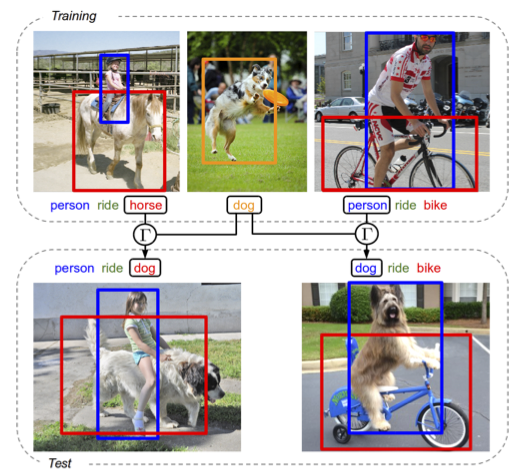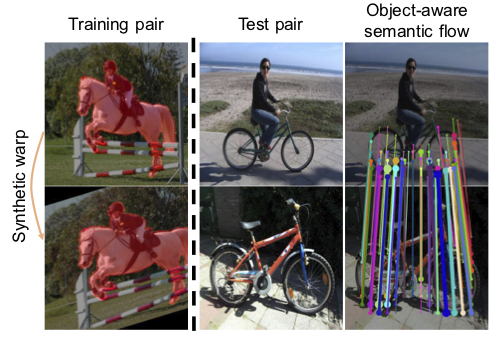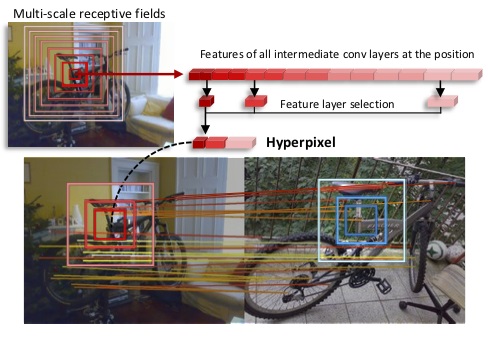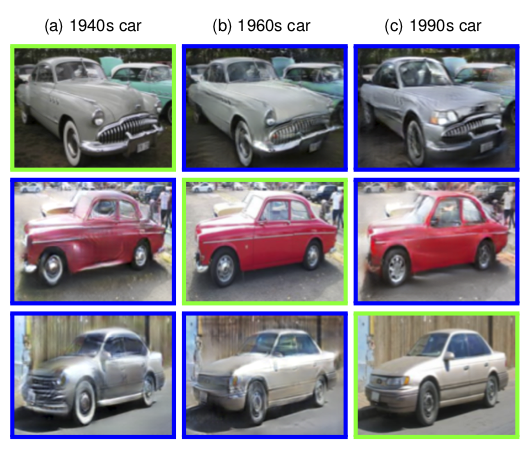Section: New Results
Category-level object and scene recognition
Detecting unseen visual relations using analogies
Participants : Julia Peyre, Ivan Laptev, Cordelia Schmid, Josef Sivic.
In [19], we seek to detect visual relations in images of the form of triplets t = (subject, predicate, object), such as “person riding dog”, where training examples of the individual entities are available but their combinations are unseen at training. This is an important set-up due to the combinatorial nature of visual relations: collecting sufficient training data for all possible triplets would be very hard. The contributions of this work are three-fold. First, we learn a representation of visual relations that combines (i) individual embeddings for subject, object and predicate together with (ii) a visual phrase embedding that represents the relation triplet. Second, we learn how to transfer visual phrase em- beddings from existing training triplets to unseen test triplets using analogies between relations that involve similar objects. Third, we demonstrate the benefits of our approach on three challenging datasets : on HICO-DET, our model achieves significant improvement over a strong baseline for both frequent and unseen triplets, and we observe similar improvement for the retrieval of unseen triplets with out-of- vocabulary predicates on the COCO-a dataset as well as the challenging unusual triplets in the UnRel dataset. Figure 5 presents an illustration of the approach.
|
SFNet: Learning Object-aware Semantic Correspondence
Participants : Junghyup Lee, Dohyung Kim, Jean Ponce, Bumsub Ham.
In [15], we address the problem of semantic correspondence, that is, establishing a dense flow field between images depicting different instances of the same object or scene category. We propose to use images annotated with binary foreground masks and subjected to synthetic geometric deformations to train a convolutional neural network (CNN) for this task. Using these masks as part of the supervisory signal offers a good compromise between semantic flow methods, where the amount of training data is limited by the cost of manually selecting point correspondences, and semantic alignment ones, where the regression of a single global geometric transformation between images may be sensitive to image-specific details such as background clutter. We propose a new CNN architecture, dubbed SFNet, which implements this idea. It leverages a new and differentiable version of the argmax function for end-to-end training, with a loss that combines mask and flow consistency with smoothness terms. Experimental results demonstrate the effectiveness of our approach, which significantly outperforms the state of the art on standard benchmarks. Figure 6 presents an illustration of the approach.
|
Hyperpixel Flow: Semantic Correspondence with Multi-layer Neural Features
Participants : Juhong Min, Jongmin Kim, Jean Ponce, Minsu Cho.
In [17], we establish visual correspondences under large intra-class variations requires analyzing images at different levels , from features linked to semantics and context to local patterns, while being invariant to instance-specific details. To tackle these challenges, we represent images by "hyper-pixels" that leverage a small number of relevant features selected among early to late layers of a convolutional neural network. Taking advantage of the condensed features of hyperpixels, we develop an effective real-time matching algorithm based on Hough geometric voting. The proposed method, hyperpixel flow, sets a new state of the art on three standard benchmarks as well as a new dataset, SPair-71k, which contains a significantly larger number of image pairs than existing datasets, with more accurate and richer annotations for in-depth analysis. Figure 7 presents an illustration of the approach.
|
Exploring Weight Symmetry in Deep Neural Networks
Participants : Xu Shell Hu, Sergey Zagoruyko, Nikos Komodakis.
In [7], we propose to impose symmetry in neural network parameters to improve parameter usage and make use of dedicated convolution and matrix multiplication routines. Due to significant reduction in the number of parameters as a result of the symmetry constraints, one would expect a dramatic drop in accuracy. Surprisingly, we show that this is not the case, and, depending on network size, symmetry can have little or no negative effect on network accuracy, especially in deep overparameterized networks. We propose several ways to impose local symmetry in recurrent and convolutional neural networks, and show that our symmetry parameterizations satisfy universal approximation property for single hidden layer networks. We extensively evaluate these parameterizations on CIFAR, ImageNet and language modeling datasets, showing significant benefits from the use of symmetry. For instance, our ResNet-101 with channel-wise symmetry has almost 25% less parameters and only 0.2% accuracy loss on ImageNet.
Bilinear image translation for temporal analysis of photo collections
Participants : Théophile Dalens, Mathieu Aubry, Josef Sivic.
In [5], we propose an approach for analyzing unpaired visual data annotated with time stamps by generating how images would have looked like if they were from different times. To isolate and transfer time dependent appearance variations, we introduce a new trainable bilinear factor separation module. We analyze its relation to classical factored representations and concatenation-based auto-encoders. We demonstrate this new module has clear advantages compared to standard concatenation when used in a bottleneck encoder-decoder convolutional neural network architecture. We also show that it can be inserted in a recent adversarial image translation architecture, enabling the image transformation to multiple different target time periods using a single network. We apply our model to a challenging collection of more than 13,000 cars manufactured between 1920 and 2000 and a dataset of high school yearbook portraits from 1930 to 2009, as illustrated in Figure 8. This allows us, for a given new input image, to generate a "history-lapse video" revealing changes over time by simply varying the target year. We show that by analyzing the generated history-lapse videos we can identify object deformations across time, extracting interesting changes in visual style over decades.
|





